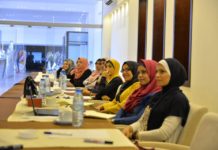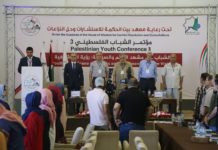Generally women traditionally wore either coats over shirts and pants or thobes with a veil – usually hanging loose down their backs.

There are distinct differences in dress between the north and south, and between village women, city women and Bedouin women. Religion also influences clothing as does class. One constant is that in all regions the body garments were worn with a girdle. However its shape and decoration is specific to an area.
Women – Northern Palestine
Initially in the north (around Nazareth & Galilee) the main garment for village women was a front opening brightly coloured coat which could be plain (dura`ah) or ornamented (jillayeh). Later (1950s) this was replaced by a different style of coat – the qumbaz – which had log sleeves and long side slits. These were worn over a long sleeved shirt (qamis) and ankle-length pants (elbas or sirwal). The pants were initially narrow and embroidered on the lower leg. With the uptake of the Turkish qumbaz the looser Turkish style of pants were also adopted.
Bedouin women in the north, by contrast wore a blue or black thobe or shirsh with long tight sleeves and a long neck opening. Decoration includes embroidery along the seams, above the hem and around the neck or four or five horizontal lines embroidered bands above the hem. (This style is similar to villages in Syria and northern Jordon).
Women – Southern Palestine
Southern village women did not wear coats but rather dresses called thobes or jillayeh. Necklines varied with region and could be round with chest slits, V-necked or scoop necked. Sleeves could be full or tight. Early examples had full skirts but this became tighter over time. Colours could be white or black depending on the region. White underdresses – or later European styled fustans and undecorated, long pants were worn under the dresses.
There is also a tradition of rich trousseau and festive dresses. In addition to embroidery these are embellished by patchwork, appliqué, and trim. The chest panel (qabbeh) is a distinctive feature of Palestinian and Syrian dresses.
Southern Bedouin women wore a similar shaped, but more voluminous, light blue or black dress (thobe) with winged sleeves. These sleeves narrowed by the 1960s. From the 1930s they also included cross stitched embroidery but in a different style to the villagers. The embroidery is usally red for women and blue for unmarried girls. Brightly coloured and patterned dresses (fustan) were worn under the overdresses.
Some of these thobes – especially around Jericho – were more than twice the length of a person and was hitched up to creating three layers and the sleeve used as a veil.
Traditional Palestinian Female Headwear
Northern Palestine most village married women wear scarves (hattah) or trains (zurband) held in place with a headband (`asbeh), Druze women wear white veils only – and the Bedouin women wear dark blue or black veils. In the cities the veils are also black.
In some parts of Palestine, married women and widows wear a tarbush shaped hat covered in coins (shatweh). While to the north they wear a coin covered bonnet (smadeh) and another horseshow shape with more coins (saffeh).
The unmarried village girls wear a bonnet (malas). In some areas when the girls reach marriageable age they switch to a wuqa which is like a simple version of the smadeh – basically a bonnet with a few coins.
While unmarried Bedouin girls wear Hattah like a bag, married women roll it like a headband.











